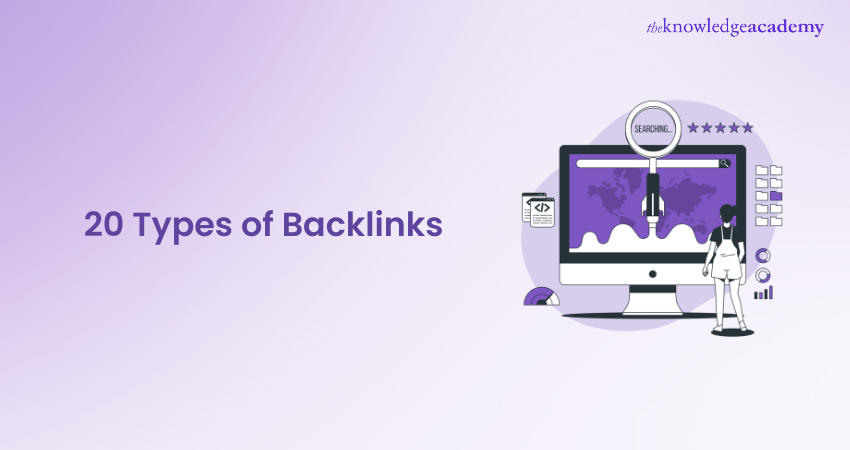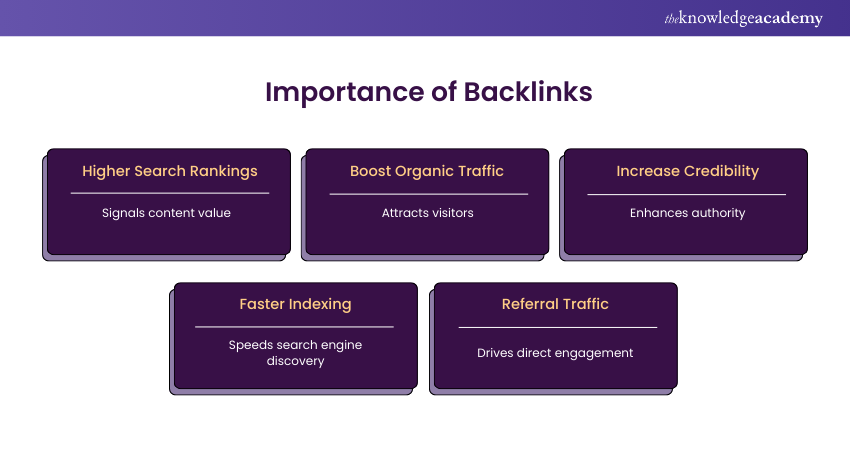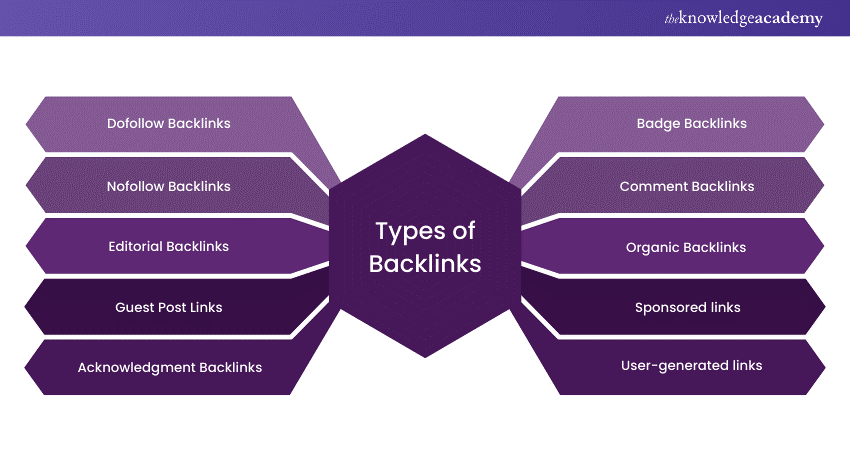We may not have the course you’re looking for. If you enquire or give us a call on +40 316317743 and speak to our training experts, we may still be able to help with your training requirements.
Training Outcomes Within Your Budget!
We ensure quality, budget-alignment, and timely delivery by our expert instructors.

Backlinks are links from other websites that point to your website. They are one of the most important factors for Search Engine Optimisation (SEO), as they indicate your website's popularity, relevance, and authority. However, not all Backlinks are created equal. Different Types of Backlinks affect your website's ranking and traffic distinctly.
This blog will explore the 20 Types of Backlinks you should know and how to use them effectively. It will also cover how to avoid the pitfalls of bad Backlinks and build a strong and diverse Backlink profile for your website. So, let’s delve in to learn more!
Table of Contents
1) What are Backlinks?
2) Why are Backlinks Important?
3) Types of Backlinks you need to know for SEO
a) Dofollow Backlinks
b) Nofollow Backlinks
c) Editorial Backlinks
d) Guest post Links
e) Acknowledgment Backlinks
f) Badge Backlinks
g) Comment Backlinks
h) Organic Backlinks
i) Sponsored Links
j) User-generated Links
4) Conclusion
What are Backlinks?
Backlinks, or Inbound or Incoming Links, are essential elements in SEO and Digital Marketing. They represent hyperlinks from one website to another, crucial in determining a site's credibility and authority. Search engines view Backlinks as endorsements, treating them as votes of confidence for the content they link to.
Quality Backlinks from reputable websites can positively impact a website's search ranking, enhancing visibility in Search Engine Results Page (SERP). However, the emphasis is on quality rather than quantity, as search engines prioritise natural and relevant Backlinks. Effective Backlink strategies contribute to improved SEO, driving organic traffic and helping Digital Marketing endeavours.
Why are Backlinks Important?
Understanding the significance of Backlinks is paramount when crafting an effective optimisation strategy. Backlinks serve as valuable endorsements, similar to votes of confidence from other authoritative websites. This essentially indicates to search engines that your content is trustworthy and valuable.

Backlinks remain a cornerstone ranking signal. Google acknowledges their critical role, identifying Backlinks as one of the top three influencing search engine rankings. Websites boasting more Backlinks tend to secure elevated positions on Google and other search engines.
This prevalence of links is not just a numerical game; it's a testament to the collective endorsement of your content by various online entities. When multiple websites link to a specific page or site, search engines interpret this as a vote of confidence, deeming the content worthy of recognition on Search Engine Results Pages (SERPs).
Gain the to thrive in the digital landscape our comprehensive Digital Marketing Courses - sign up now!
Types of Backlinks you need to know for SEO
Here is a list of the most common Types of Backlinks:

1) Dofollow Backlinks
Dofollow Backlinks have been crucial to SEO since the creation of Google's PageRank algorithm. These links, lacking the "nofollow" attribute, act as strong endorsements, allowing link equity to transfer between websites. They are vital for establishing a site's credibility and relevance, significantly impacting search engine rankings.
As key elements of SEO strategies, Dofollow Backlinks enhance a website's authority, trustworthiness, and visibility in search results. This makes them indispensable for a robust online presence.
2) Nofollow Backlinks
NoFollow links were introduced by search engines in 2005, including Google, to address the issue of spammy or irrelevant links impacting search rankings. Websites can designate links as NoFollow to signal that they shouldn't pass SEO authority to the linked site.
While these links don't directly contribute to search rankings, they play a crucial role in maintaining a balanced link profile, adhering to search engine guidelines, and preventing the misuse of link schemes. NoFollow links are often used in user-generated content, comments, and sponsored content. They allow websites to strategically manage the flow of link equity.
3) Editorial Backlinks
Editorial Backlinks are naturally occurring links that arise from authoritative websites recognising and linking to high-quality content. Unlike manipulated links, they signify genuine endorsements, reflecting a site's trustworthiness and expertise. Rooted in Google's PageRank algorithm, these links enhance a site's visibility and authority in search engine results.
Their authenticity and earned nature make them potent indicators of editorial approval and relevance. As essential components of a robust link profile, Editorial Backlinks remain critical for long-term SEO success, significantly boosting a site's search engine rankings and credibility.
4) Guest Post Links
Guest Post Links have become a key component in SEO, originating from the collaborative practice of authors contributing quality content to external platforms in exchange for Backlinks. These links diversify Backlink profiles, promote cross-platform engagement, and expand audiences.
Search engines recognise the authenticity of Guest Post Links, enhancing a website's authority and visibility. As a cornerstone of effective link-building strategies, they offer mutual benefits to both contributors and host platforms, solidifying their role in modern SEO practices.
5) Acknowledgment Backlinks
Acknowledgement Backlinks are a form of online recognition for noteworthy contributions or content. Originating from the desire to credit valuable creators, these links have become essential to SEO strategies. They enhance a website's authority and reputation by testifying to its expertise, content quality, and industry recognition.
In modern SEO, acknowledgement Backlinks significantly boost a site's standing, reflecting its positive impact within a specific niche or industry. By fostering a collaborative online environment, they provide meaningful endorsements that contribute to a robust link profile and improved search engine rankings.
Transform your digital presence and elevate your website's visibility with our SEO Course - join today!
6) Badge Backlinks
Badge Backlinks are visual indicators of recognition or achievement, contributing to a website's SEO strategy. When websites receive badges or awards for their expertise, these badges often include Backlinks, creating a valuable link-building opportunity.
These visual endorsements enhance the site's authority and serve as a trustworthy representation of its achievements. Badge Backlinks play a dual role in SEO, showcasing credibility to search engines and users. Their usefulness lies in their ability to convey expertise, foster trust, and contribute positively to a website's visibility and reputation in the digital landscape.
7) Comment Backlinks
Comment Backlinks are a valuable component of SEO, leveraging user engagement to enhance a website's authority and visibility. By actively participating in relevant discussions on blogs or articles, individuals can secure links back to their content. These links contribute to a diverse Backlink profile and establish a connection between the contributor's expertise and the ongoing conversation.
When placed thoughtfully, comment Backlinks provide a dual benefit—strengthening SEO standing while fostering community engagement. This interactive approach aligns with search engine algorithms, recognising the importance of genuine user contributions in shaping a website's online presence and credibility.
8) Organic Backlinks
Organic Backlinks are invaluable assets in SEO, representing genuine endorsements from other websites. These links are naturally acquired and emerging due to high-quality, shareable content that resonates with users. Unlike manipulated links, organic Backlinks indicate a website's credibility, relevance, and authority within its niche.
These endorsements, earned through merit, contribute significantly to search engine rankings, enhancing visibility and driving organic traffic. Organic Backlinks validate a site's authenticity and foster a robust and interconnected web ecosystem where quality content is acknowledged and rewarded, making them an essential element in any comprehensive SEO strategy.
9) Sponsored Links
Sponsored links play a pivotal role in SEO strategies by offering a valuable avenue for brand visibility and targeted traffic. While marked as nofollow to comply with search engine guidelines, these links enable businesses to cultivate collaborative relationships, enhance brand recognition, and drive potential customers to their websites.
Leveraging sponsored links in partnerships and sponsorships contributes to a diversified Backlink profile, supporting a comprehensive online presence. Though not directly influencing search rankings, these links prove instrumental in expanding audience reach, fostering industry connections, and establishing a compelling digital footprint within the online landscape.
10) User-generated Links
User-generated links are valuable assets in SEO, embodying genuine endorsements from a community. Created organically by users on forums, social media, or collaborative platforms, these links authentically showcase a website's relevance and authority. Their utility lies in reflecting real user engagement and contributing to diverse Backlink profiles.
These links are potent indicators of community trust, aiding search engines in evaluating a site's credibility. User-generated links foster a sense of community endorsement, positively influencing search rankings. Leveraging the collective power of user contributions, these links are vital in enhancing SEO visibility and establishing a website's authenticity within its online ecosystem.
Elevate your Digital Marketing expertise with our immersive Digital Marketing Course - register now!
11) Text Content Hyperlinks
Text content hyperlinks are essential for SEO, embedding clickable text within a webpage's content. These links serve as navigational aids, seamlessly connecting relevant information and enhancing user experience. In SEO, text content hyperlinks contribute to a website's overall structure and coherence, facilitating easy access to related content.
By strategically placing hyperlinks within textual context, websites improve search engine rankings and user engagement. These links also enable search engines to comprehend the content's interconnectedness, emphasising the importance of organic and contextually relevant linking strategies for a robust SEO foundation.
12) Links Inside Images
Links inside images, a common practice in web design, enhance the visual appeal of a website while providing an alternative navigation method. In SEO, these hyperlinks embedded within images contribute to a more immersive user experience, improving accessibility and engagement.
When optimised with relevant alt text and associated with valuable content, these links can strengthen a web page's SEO profile. They add a layer of interactivity and offer an aesthetically pleasing way to connect users with essential information. However, striking a balance is crucial, ensuring that image links complement the overall content strategy and align with search engine guidelines.
13) Footer Hyperlinks
Footer hyperlinks, commonly positioned in the bottom section of a webpage, serve as a comprehensive navigation menu. While they contribute to website usability, their impact on SEO varies. Search engines may place less emphasis on links in the footer, considering them site-wide links. While footer hyperlinks can enhance overall navigation, it's crucial to prioritise quality over quantity.
Strategic placement of key links in the footer can still provide valuable user assistance and contribute to a well-organised site structure. Balancing usability with SEO considerations ensures that footer hyperlinks remain a functional and user-friendly aspect of website design.
14) Widget-embedded Hyperlinks
Widget-embedded hyperlinks play a vital role in SEO by strategically integrating links within website widgets. These hyperlinks enhance a site's functionality, offering supplementary information or facilitating user interaction. Their placement within widgets ensures a seamless and enriched user experience, aligning with the overall design and purpose of the widget.
These links contribute to a cohesive navigation structure, promoting user engagement and providing valuable pathways to relevant content. While fostering an intuitive interface, widget-embedded hyperlinks also serve as an effective strategy for diversifying a website's Backlink profile, positively impacting its SEO standing and overall online visibility.
15) Pillow Links
Pillow links in SEO represent a gradual and natural link-building approach. Unlike aggressive tactics, these links accumulate over time through genuine interactions, organic content creation, and authentic engagement. This soft, non-intrusive strategy helps develop a diverse and authentic Backlink profile.
By mimicking a natural link-building process, pillow links enhance a website's SEO standing, fostering a sustainable, long-term approach. This helps in building credibility and authority in the digital landscape.
Unlock the strategies and tactics to become a successful affiliate marketer with our Affiliate Marketing Course today!
16) Authority Links
Authority links, derived from highly reputable and influential websites, serve as a cornerstone in SEO strategy. Acquiring links from these authoritative sources significantly enhances a website's credibility, trustworthiness, and overall, SEO standing. Search engines consider such links as strong endorsements of content quality and relevance, leading to improved search rankings.
The influence of authority links extends beyond mere SEO benefits, impacting brand perception and establishing the linked site as an industry leader. Strategically integrating authority links into a Backlink profile contributes to a well-rounded and authoritative online presence, aligning with the broader goals of organic search visibility and user trust.
17) Contextual Links
Contextual links play a pivotal role in SEO by seamlessly integrating within the content narrative. Unlike standalone links, contextual links are embedded within relevant text, providing additional information or directing users to related resources. These links enhance the overall user experience, contributing to a cohesive and informative flow of content.
From a search engine perspective, contextual links are viewed as natural endorsements of a website's authority on a specific topic, positively impacting its rankings. Their strategic placement within the context of meaningful content not only aids in navigation but also strengthens the website's relevance and credibility within its niche.
Transform words into persuasive magic with our Copywriting Course. Sign up at the earliest!
18) Testimonial Backlinks
Earn valuable Backlinks by providing testimonials or reviews for products, services, or businesses you genuinely use. This strategy benefits both parties: businesses gain social proof, enhancing their credibility and reputation, while reviewers secure link-building opportunities.
Simply select products or services you have experience with, pitch your testimonial to the company, and create your review. This approach fosters mutual benefit, boosting the business's trustworthiness and offering the reviewer a chance to strengthen their Backlink profile.
19) Unlinked Brand Mentions
Unlinked brand mentions, such as when a website discusses your brand, case study, or research without linking to you, offer excellent link-building opportunities. Use an SEO tool to find these mentions:
Navigate to the tool's content explorer and search for your brand name.
a) Apply filters for recent publications, language, and live content
b) Highlight unlinked mentions by entering your domain name
c) Analyse prospects and target those with high domain authority and topical relevance
This approach helps you identify and convert mentions into valuable Backlinks.
20) PBN Backlinks
Private Blog Network (PBN) Backlinks are created from a network of interlinked websites, typically owned by a single entity. While less popular today, some SEOs still use them to increase a website's authority through controlled links. SEO specialists purchase domains, fill them with content, and then add Backlinks to their main site.
These Backlinks can be from the PBN's blog or homepage, but the process must vary across domains to avoid patterns. PBN links are considered a grey hat SEO technique, as Google discourages their use due to PageRank manipulation, so caution is advised.
Conclusion
Understanding the nuances of Types of Backlinks is paramount for a robust SEO strategy. From dofollow to organic links, acknowledging the diverse ecosystem of different Types of Backlinks is pivotal for enhancing website authority and visibility. Elevate your digital presence by harnessing the power of these strategic link-building avenues.
Gain insights, optimise performance, and elevate your online presence with our Google Analytics Training - Join now!
Frequently Asked Questions

Broken link building involves the following:
1) Finding broken links on other websites
2) Creating related content to replace the dead link
3) Reaching out to the site owner to propose your link as a replacement

Image Backlinks are created when other websites use your images and link back to your site as the source. To create them, upload high-quality images, use descriptive filenames and alt text, and submit your images to relevant directories and social platforms.

The Knowledge Academy takes global learning to new heights, offering over 30,000 online courses across 490+ locations in 220 countries. This expansive reach ensures accessibility and convenience for learners worldwide.
Alongside our diverse Online Course Catalogue, encompassing 17 major categories, we go the extra mile by providing a plethora of free educational Online Resources like News updates, Blogs, videos, webinars, and interview questions. Tailoring learning experiences further, professionals can maximise value with customisable Course Bundles of TKA.

The Knowledge Academy’s Knowledge Pass, a prepaid voucher, adds another layer of flexibility, allowing course bookings over a 12-month period. Join us on a journey where education knows no bounds.

The Knowledge Academy offers various Digital Marketing Courses, including Digital Marketing masterclass, Social Media Marketing Course, and Digital Email Marketing Masterclass. These courses cater to different skill levels, providing comprehensive insights into SEO Backlinks.
Our Digital Marketing Blogs cover a range of topics related to SEO and Backlinking, offering valuable resources, best practices, and industry insights. Whether you are a beginner or looking to advance your Email Marketing skills, The Knowledge Academy's diverse courses and informative blogs have you covered.
Upcoming Digital Marketing Resources Batches & Dates
Date
 Digital Marketing Course
Digital Marketing Course
Fri 24th Jan 2025
Fri 28th Mar 2025
Fri 23rd May 2025
Fri 25th Jul 2025
Fri 26th Sep 2025
Fri 28th Nov 2025







 Top Rated Course
Top Rated Course



 If you wish to make any changes to your course, please
If you wish to make any changes to your course, please


